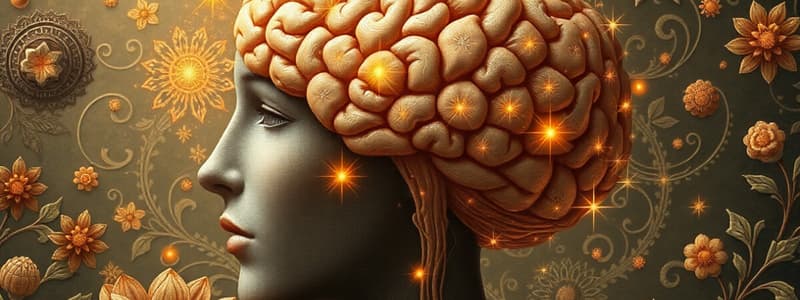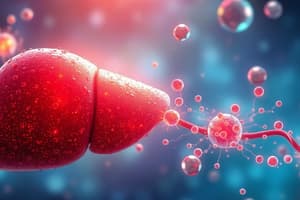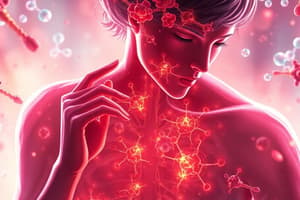Podcast
Questions and Answers
What are the four main parts of the brain?
What are the four main parts of the brain?
Cerebrum, thalamus, brainstem, cerebellum
What parts of the brain constitute the "Old Brain?"
What parts of the brain constitute the "Old Brain?"
Thalamus, brainstem, cerebellum
Which part of the brain constitutes the "New Brain?"
Which part of the brain constitutes the "New Brain?"
Cerebrum
What does the term "inhibitory" mean in the context of drug effects on neurons?
What does the term "inhibitory" mean in the context of drug effects on neurons?
Which group of drugs are typically considered inhibitory?
Which group of drugs are typically considered inhibitory?
What does the term "excitatory" mean in the context of drug effects on neurons?
What does the term "excitatory" mean in the context of drug effects on neurons?
Which group of drugs are typically considered excitatory?
Which group of drugs are typically considered excitatory?
Describe the key steps involved in sending a nerve impulse (action potential).
Describe the key steps involved in sending a nerve impulse (action potential).
What are the four lobes of the cerebrum?
What are the four lobes of the cerebrum?
What functions are primarily controlled by the frontal lobe?
What functions are primarily controlled by the frontal lobe?
What does the parietal lobe control?
What does the parietal lobe control?
Which sense is primarily processed by the occipital lobe?
Which sense is primarily processed by the occipital lobe?
The temporal lobe is primarily responsible for controlling which functions?
The temporal lobe is primarily responsible for controlling which functions?
What are the main functions of the cerebellum?
What are the main functions of the cerebellum?
What are the two main parts of the brainstem mentioned?
What are the two main parts of the brainstem mentioned?
What vital function is the medulla oblongata primarily responsible for regulating?
What vital function is the medulla oblongata primarily responsible for regulating?
What vital function is the pons primarily responsible for controlling?
What vital function is the pons primarily responsible for controlling?
Maintaining the body's internal balance (homeostasis) is the primary responsibility of which brain structure?
Maintaining the body's internal balance (homeostasis) is the primary responsibility of which brain structure?
What is the corpus callosum and what is its main function?
What is the corpus callosum and what is its main function?
What is the primary role of the thalamus?
What is the primary role of the thalamus?
What are the four parts of the brain?
What are the four parts of the brain?
What are the parts of the "Old Brain?"
What are the parts of the "Old Brain?"
What are the parts of the "New Brain?"
What are the parts of the "New Brain?"
What does the term "inhibitory" mean?
What does the term "inhibitory" mean?
Which drugs are considered inhibitory?
Which drugs are considered inhibitory?
What does the term excitatory mean?
What does the term excitatory mean?
Which drugs are considered excitatory?
Which drugs are considered excitatory?
What are the steps involved in sending a nerve impulse?
What are the steps involved in sending a nerve impulse?
What are the parts of the cerebrum?
What are the parts of the cerebrum?
What does the frontal lobe control?
What does the frontal lobe control?
What does the parietal lobe control?
What does the parietal lobe control?
What does the occipital lobe control?
What does the occipital lobe control?
What does the temporal lobe control?
What does the temporal lobe control?
What does the cerebellum do?
What does the cerebellum do?
What are the two parts of the brainstem?
What are the two parts of the brainstem?
What is the medulla responsible for?
What is the medulla responsible for?
What is the pons responsible for?
What is the pons responsible for?
What is the hypothalamus responsible for?
What is the hypothalamus responsible for?
What is the corpus callosum?
What is the corpus callosum?
What does the thalamus do?
What does the thalamus do?
What are the four main parts of the brain?
What are the four main parts of the brain?
Which parts of the brain are sometimes referred to as the "Old Brain?"
Which parts of the brain are sometimes referred to as the "Old Brain?"
Which part of the brain is sometimes referred to as the "New Brain?"
Which part of the brain is sometimes referred to as the "New Brain?"
In neuroscience, what does the term "inhibitory" mean?
In neuroscience, what does the term "inhibitory" mean?
Which common drugs are often classified as inhibitory?
Which common drugs are often classified as inhibitory?
In neuroscience, what does the term "excitatory" mean?
In neuroscience, what does the term "excitatory" mean?
Which common drugs are often classified as excitatory?
Which common drugs are often classified as excitatory?
Briefly describe the key steps involved in the transmission of a nerve impulse (action potential).
Briefly describe the key steps involved in the transmission of a nerve impulse (action potential).
What are the four lobes of the cerebrum?
What are the four lobes of the cerebrum?
What functions are primarily controlled by the frontal lobe?
What functions are primarily controlled by the frontal lobe?
What functions are primarily controlled by the parietal lobe?
What functions are primarily controlled by the parietal lobe?
What function is primarily controlled by the occipital lobe?
What function is primarily controlled by the occipital lobe?
What functions are primarily controlled by the temporal lobe?
What functions are primarily controlled by the temporal lobe?
What are the main functions of the cerebellum?
What are the main functions of the cerebellum?
What are the two main parts of the brainstem?
What are the two main parts of the brainstem?
What vital function is primarily regulated by the medulla?
What vital function is primarily regulated by the medulla?
What vital function is primarily regulated by the pons?
What vital function is primarily regulated by the pons?
What is the primary responsibility of the hypothalamus?
What is the primary responsibility of the hypothalamus?
What is the corpus callosum and what is its function?
What is the corpus callosum and what is its function?
What is the main function of the thalamus?
What is the main function of the thalamus?
Flashcards
What are the four brain parts?
What are the four brain parts?
Cerebrum, thalamus, brainstem, cerebellum
What's in the 'Old Brain'?
What's in the 'Old Brain'?
Thalamus, brainstem, cerebellum
What's in the 'New Brain'?
What's in the 'New Brain'?
Cerebrum
What does 'inhibitory' mean?
What does 'inhibitory' mean?
Signup and view all the flashcards
Which drugs are inhibitory?
Which drugs are inhibitory?
Signup and view all the flashcards
What does 'excitatory' mean?
What does 'excitatory' mean?
Signup and view all the flashcards
Which drugs are excitatory?
Which drugs are excitatory?
Signup and view all the flashcards
Steps to send a nerve impulse?
Steps to send a nerve impulse?
Signup and view all the flashcards
What are the cerebrum's parts?
What are the cerebrum's parts?
Signup and view all the flashcards
Frontal lobe controls?
Frontal lobe controls?
Signup and view all the flashcards
Parietal lobe controls?
Parietal lobe controls?
Signup and view all the flashcards
Occipital lobe controls?
Occipital lobe controls?
Signup and view all the flashcards
Temporal lobe controls?
Temporal lobe controls?
Signup and view all the flashcards
What does the cerebellum do?
What does the cerebellum do?
Signup and view all the flashcards
Brainstem's two parts?
Brainstem's two parts?
Signup and view all the flashcards
Medulla is responsible for?
Medulla is responsible for?
Signup and view all the flashcards
Pons is responsible for?
Pons is responsible for?
Signup and view all the flashcards
Hypothalamus controls?
Hypothalamus controls?
Signup and view all the flashcards
What is the corpus callosum?
What is the corpus callosum?
Signup and view all the flashcards
What does the thalamus do?
What does the thalamus do?
Signup and view all the flashcards
Study Notes
- The four main parts of the brain are the cerebrum, thalamus, brainstem, and cerebellum.
- The "Old Brain" consists of the thalamus, brainstem, and cerebellum.
- The "New Brain" is the cerebrum.
Inhibitory Drugs
- These drugs slow down the firing process between neurons.
- They cause the charge in the axon to become more negative.
- This makes it take longer for the neuron to reach depolarization and send an action potential.
- Examples: Heroin, marijuana, alcohol, and sometimes LSD.
Excitatory Drugs
- These drugs speed up the firing process between neurons.
- They make the charge of the axon more positive.
- This makes it take a shorter amount of time for the neuron to depolarize and send an action potential.
- Examples: Ecstasy, methamphetamines, cocaine, and sometimes LSD.
Nerve Impulse Transmission
- Resting state: neuron has a polarized membrane at -70mV.
- There are more Na+ ions outside and fewer K+ ions inside the neuron.
- The outside of the cell is more positive than the inside.
- The membrane is mostly impermeable.
- Depolarization: neuron receives a chemical signal.
- The charge becomes -55mV, hitting the threshold.
- Sodium voltage-gated channels open, causing sodium to rush into the axon.
- Repolarization: neuron reaches +40mV.
- Sodium voltage-gated channels close.
- Potassium voltage-gated channels open, causing potassium to rush out of the cell.
- Hyperpolarization: loss of potassium ions causes the membrane to become charged at -85mV.
- Potassium voltage-gated channels close.
- Sodium-potassium pumps move 3 sodium ions out and 2 potassium ions into the neuron, returning it to a resting state at -70mV.
- The process repeats down the axon to the axon terminal and then to another neuron.
Cerebrum Lobes
- The parts of the cerebrum are the frontal lobe, parietal lobe, occipital lobe, and temporal lobe.
- The Frontal lobe controls emotions, personality, and memories.
- The Parietal lobe controls bodily sensations, sense of touch, and body position.
- The Occipital lobe controls vision.
- The Temporal lobe controls hearing, language, and some memory.
- The Cerebellum controls balance and coordination, motor control, and motor memory.
Brainstem
- The two parts of the brainstem are the medulla and pons.
- The Medulla controls heart rate.
- The Pons controls breathing.
- The Hypothalamus is responsible for homeostasis.
- The Corpus callosum is the connection of nerves between the two hemispheres of the brain.
- Corpus callosum allows the two hemispheres to communicate and opposite hemispheres control opposite sides of the body.
- The Thalamus filters and sends information to the other parts of the brain.
Studying That Suits You
Use AI to generate personalized quizzes and flashcards to suit your learning preferences.




